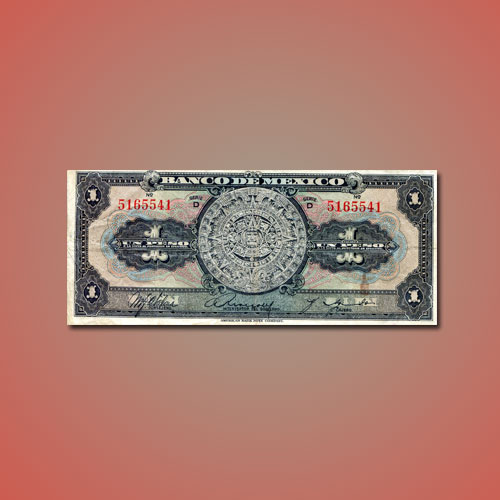Mexican Archaeological Wonder on a Banknote
2020-06-17 Wed
The first banknotes issued by the Mexican state were produced in 1823 by Emperor Agustin de Iturbide. Several Mexican banknotes bore motifs related to the Aztecs or other pre-Hispanic cultures. The banknote shown above is a 1 Peso banknote issued in the year 1961 which depicts the Mexican Sunstone. The Aztec Calendar Stone, better known in the archaeological literature as the Aztec Sun Stone (Piedra del Sol in Spanish), is an enormous basalt disk covered with hieroglyphic carvings of calendar signs and other images referring to the Aztec creation myth. The so-called Aztec Calendar Stone was not a calendar, but most likely a ceremonial container or altar linked to the Aztec sun god, Tonatiuh, and festivities dedicated to him. The 1 Peso banknote shown above depicts Aztec calendar stone or Mexica Sunstone (Piedra del Sol) excavated in the Zocalo, Mexico City's main square, on the 17th of December 1790, whereas the reverse depicts Independence Monument in Mexico City. Image Courtesy: currencybanknotes.comLatest News
-
Malwa Sultan Mahmud Shah Silver Coins
2025-09-11 ThuMalwa Sultan Mahmud Shah minted silver coins in round and square flans. <br><br> For round coins,...
-
Malwa Sultan Mahmud Shah Billon coin
2025-08-26 TueMalwa Sultan Mahmud Shah's billon coins followed three weight standards: 100 rati, 96 rati, and 80 r...
-
Fascinating Archaeological Facts on Postage Stamps - 91
2025-08-23 SatRhinoceros is one of the oldest land mammal species existing in India. There are five species of rhi...
-
Fascinating Archaeological Facts on Postage Stamps - 90
2025-08-23 SatUthiramerur, a Village in Kanchipuram, Tamil Nadu, is notable for its Temple inscriptions that descr...
-
Fascinating Archaeological Facts on Postage Stamps - 89
2025-08-21 ThuThe term “millet” is derived from the Latin word “milum,” which translates to grain. millets...

